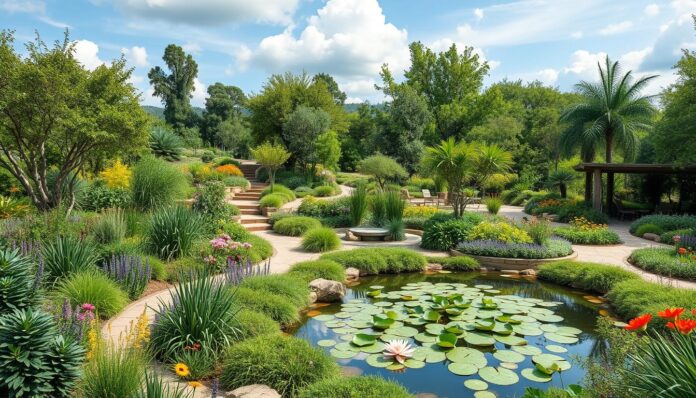The first time I visited a permaculture mental sanctuary, something magical happened. I was surrounded by lush greenery and carefully arranged plants. I felt an immediate calm wash over me. It was more than a garden—it was a living, breathing ecosystem designed to heal both land and human spirit.
Permaculture is more than just a sustainable gardening approach. It turns nature into a powerful tool for healing. Studies show that being in nature can greatly reduce stress and help us recover mentally. It transforms outdoor spaces into places of healing.
By combining ecological practices with intentional design, permaculture systems offer a unique way to improve mental health. Nature-based therapies provide deep psychological benefits. They create spaces that nurture both physical and emotional well-being.
Key Takeaways
- Permaculture designs create holistic healing environments
- Ecological engagement reduces stress and promotes mental recovery
- Gardens can serve as therapeutic spaces for emotional restoration
- Sustainable design supports psychological well-being
- Nature interaction provides comprehensive healing experiences
Understanding Permaculture and Its Principles
Permaculture is a new way to live sustainably. It combines creative design with nature’s wisdom. This approach changes how we see our environment.
Defining Permaculture
Permaculture is based on three main ethics: caring for the Earth, people, and the future. These ethics help us create systems that work with nature.
“Permaculture is about designing sustainable landscapes that provide food, energy, shelter, and other material and non-material needs in a way that benefits the planet and its inhabitants.”
Key Principles of Permaculture
- Observe and interact with natural systems
- Capture and store energy efficiently
- Obtain sustainable yields
- Apply self-regulation and accept feedback
- Use and value renewable resources
Benefits of Permaculture in Horticulture
Permaculture brings many benefits to gardening. Studies show it can:
- Improve soil fertility by up to 50%
- Increase crop yields by 20-30%
- Enhance water retention by 40%
- Reduce input costs by 30-50%
- Boost biodiversity by 30-60%
By using permaculture, gardens can become productive and healthy. They support both people and the environment.
The Concept of Therapeutic Horticulture
Therapeutic horticulture is a powerful way to heal. It combines nature’s power with human well-being. This practice turns gardens into places for mental and emotional healing.
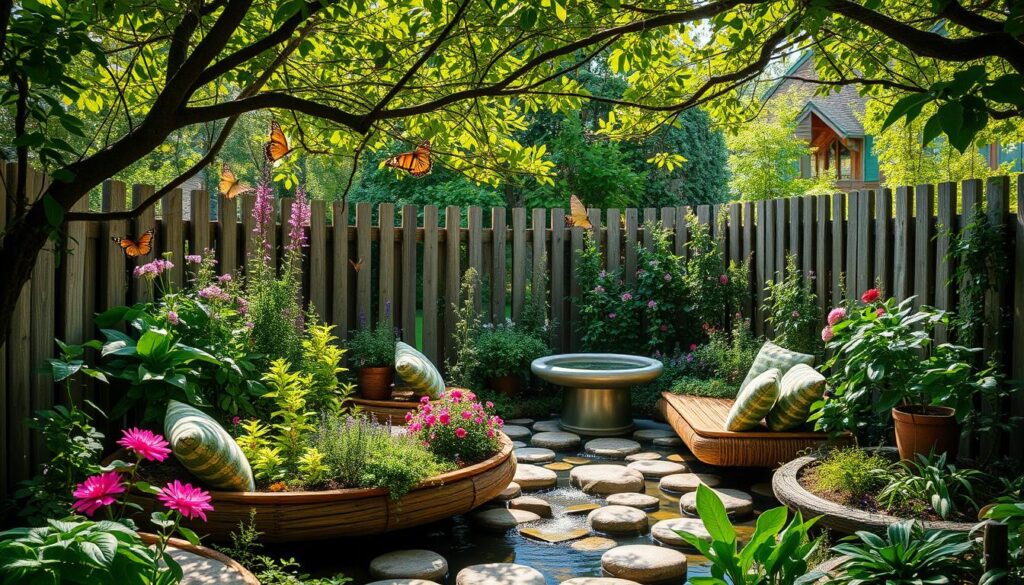
It uses plants to help with mental health and growth. Unlike regular gardening, it designs spaces for healing and connection.
Definition of Therapeutic Horticulture
At its heart, therapeutic horticulture uses plants to improve well-being. The biophilic harmony sanctuary in gardens offers big psychological benefits.
Historical Context and Development
- Started in the 1940s in rehab programs
- Became a formal discipline in the 1970s
- Is now recognized globally in healthcare
Benefits for Mental Health
| Mental Health Benefit | Percentage Improvement |
|---|---|
| Stress Reduction | 20% |
| Mood Enhancement | 40% |
| Mindfulness Development | 35% |
“Nature itself is the most powerful therapeutic environment we can experience.” – Environmental Psychologist
Studies show plants can lower stress hormones and boost mood. They also help with thinking better. Green spaces can greatly improve mental health.
Therapeutic horticulture keeps growing. It offers a complete healing approach that links people with nature’s healing power.
How Permaculture Enhances Therapeutic Horticulture
Permaculture is a new way to make places that help our minds heal. It uses nature’s wisdom to create spaces for growth and wellness.
Permaculture and gardening together make special places. These places help both people and nature. They are more than just gardens.
Ecological Benefits of Therapeutic Gardens
- Supports local wildlife and biodiversity
- Creates sustainable mental health environments
- Reduces stress through natural interaction
Studies show that gardens help people’s minds a lot. People in permaculture programs feel better in many ways.
| Wellness Metric | Improvement Percentage |
|---|---|
| Mental Well-being | 50% |
| Anxiety Reduction | 65% |
| Sense of Community | 40% |
Nurturing Well-Being through Design
Therapeutic gardens become living systems that adapt and respond to human emotional needs. They use many plants and sights to help heal minds.
“In nature, nothing is perfect and everything is perfect.” – Alice Walker
Biodiversity in Therapy
Permaculture makes spaces that help our minds. These gardens use over 30 plants to heal.
These gardens are more than green spaces. They are places of healing and growth, thanks to nature’s design.
Designing Therapeutic Horticulture Spaces
Creating a permaculture mental sanctuary needs careful planning. It should follow holistic mindscape design principles. Gardens can become healing places when they engage all senses and support mental health.
Elements of Therapeutic Gardens
Therapeutic gardens offer many sensory experiences. They include:
- Comfortable seating areas for quiet reflection
- Pathways with gentle gradients for accessibility
- Diverse plant textures and colors
- Water features for calming sounds
- Spaces that encourage interaction with nature
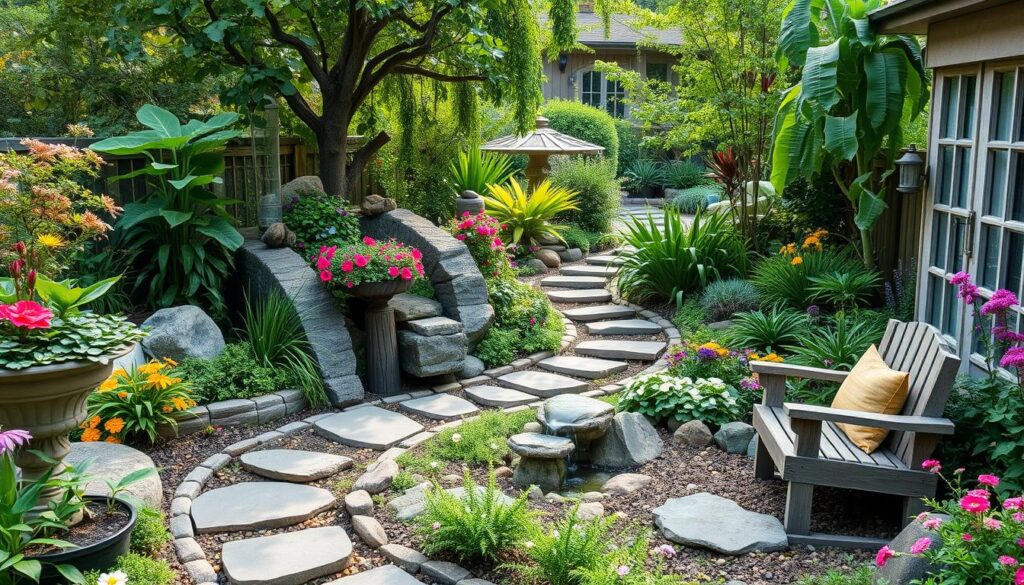
Permaculture Techniques for Design
Permaculture design brings new ideas to healing spaces. It uses natural ecosystems as guides. This way, gardens become both useful and therapeutic.
| Permaculture Technique | Therapeutic Benefit |
|---|---|
| Zonal Planning | Reduces physical strain |
| Diverse Plant Selection | Stimulates sensory engagement |
| Energy-Efficient Design | Minimizes maintenance stress |
Considerations for Accessibility
Creating an inclusive permaculture mental sanctuary means welcoming all. Gentle gardening practices make sure everyone can enjoy nature’s healing.
A well-designed garden speaks to the soul, offering healing beyond physical boundaries.
Studies show that horticultural therapy can reduce mental health symptoms by up to 40%. Thoughtful design turns these spaces into powerful tools for healing.
Plant Selection for Therapeutic Gardens
Creating a nature-inspired wellbeing sanctuary needs careful plant selection. The right plants can turn a garden into a healing space. This space nurtures both body and mind.
Native Plants: Roots of Healing
Native plants are key to a successful therapeutic garden. They offer many benefits:
- They’re adapted to local climate conditions
- They support local ecosystem health
- They need less maintenance
- They provide habitats for local wildlife
Edible Plants: Nourishing Therapy
Adding edible plants to therapeutic gardens is unique. Growing food brings:
- A sense of accomplishment
- A direct connection with nature
- Nutritional benefits
- Stress reduction through gardening
“Every garden is a form of autobiography” – Robert Dash
Aromatic Plants: Sensory Healing
Fragrant plants make therapeutic gardens even more special. Lavender, chamomile, and rosemary offer calming aromatherapy. They also help create a healing environment.
| Plant Type | Therapeutic Benefits |
|---|---|
| Lavender | Stress reduction, sleep improvement |
| Chamomile | Anxiety relief, digestive support |
| Rosemary | Memory enhancement, mental clarity |
By choosing plants that heal, gardeners can make powerful spaces. These spaces help us connect with nature.
The Role of Community in Therapeutic Horticulture
Community is key in therapeutic horticulture, making spaces that help everyone feel better. Together, people grow gardens and connect with nature and each other.
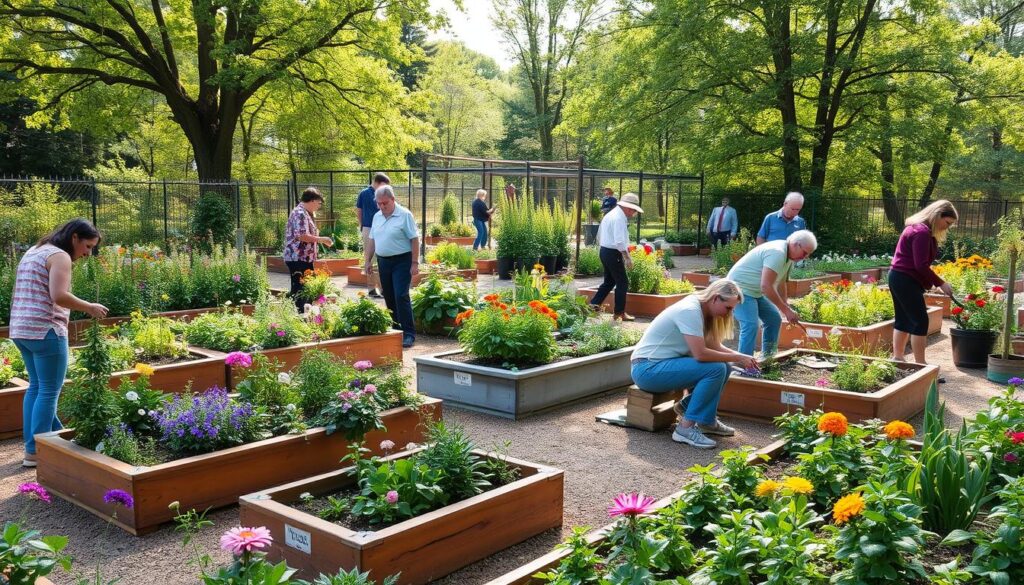
Community Engagement in Garden Projects
Getting communities involved in gardening projects is good for everyone’s mental and social health. Studies show big improvements in well-being from working together in gardens.
- Reduce stress levels by up to 60%
- Increase self-esteem by approximately 50%
- Improve social interactions by 40%
- Enhance psychological well-being by 55%
Workshops and Educational Programs
Learning to garden is made easier through educational programs. Workshops help people learn new skills and make friends.
| Program Type | Duration | Focus Area |
|---|---|---|
| Certificate in Therapeutic Horticulture | 70 hours | Horticultural Skills |
| Weekend Training | 1-2 days | Practical Gardening |
| Community Garden Program | Ongoing | Social Integration |
Building Social Connections
Community gardens are great for making friends and creating welcoming places. Therapeutic horticulture goes beyond gardening by helping people connect and learn together.
Gardens are not made by sitting in the shade, but by collective effort and shared passion.
Case Studies of Successful Permaculture Therapeutic Projects
Permaculture projects are changing communities for the better. They create places where people and nature can thrive together. These projects show how design and nature can help heal our minds.
Therapeutic gardening is more than just a hobby. It’s a way to heal and find peace. By using nature, we can make spaces that help our bodies and minds feel better.
Urban Therapeutic Horticulture Innovations
Cities are being turned into green spaces. Old lots and empty areas are now places of healing. These changes bring many benefits:
- Reduction in anxiety symptoms by up to 30%
- Significant decrease in stress hormone levels
- Improved mood and self-esteem
- Enhanced community social connections
Rural Community Garden Successes
Rural areas are becoming havens for nature and people. Gardening programs connect communities and show great results:
| Therapeutic Outcome | Percentage Improvement |
|---|---|
| Dementia Risk Reduction | 50% |
| Pharmacological Intervention Decrease | 20% |
| Overall Quality of Life | 15% |
School-Based Permaculture Programs
Schools are using gardening to help students. Hands-on gardening experiences teach and heal. Research shows that being in nature can boost our mood.
“Getting hands dirty in the garden can increase serotonin levels, offering a natural approach to mental wellness.” – Environmental Health Research
These examples show how permaculture can change lives. It creates spaces where everyone can find peace and grow together.
The Therapeutic Process of Gardening
Gardening is more than just growing plants. It’s a journey of wellbeing inspired by nature. It offers a way to connect with the world around us. By working with plants and soil, people find healing.
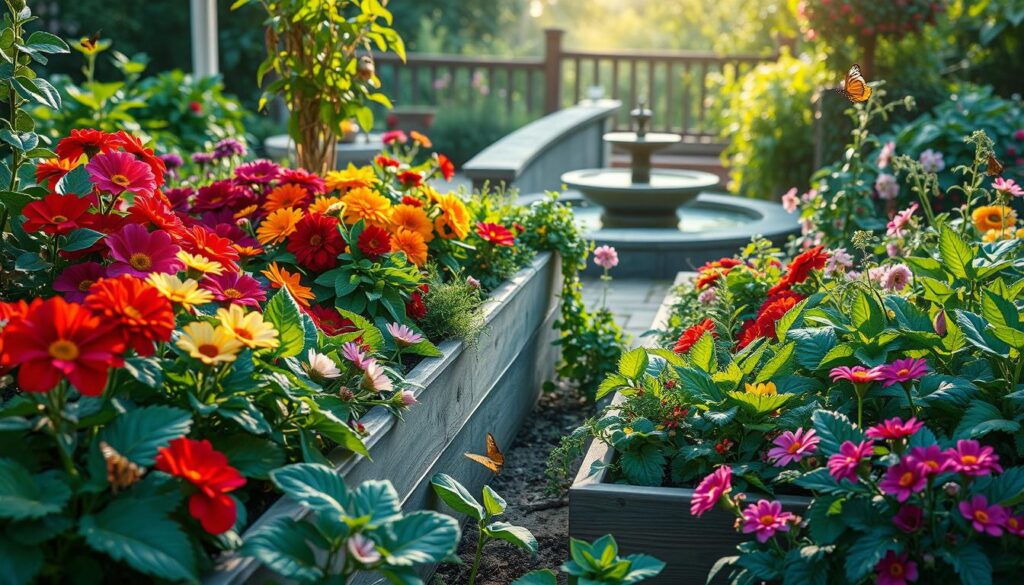
Studies show gardening’s power to heal. Being in green spaces can greatly improve our mental and physical health.
Physical Benefits of Gardening
Gardening is good for our bodies:
- It makes muscles stronger and more flexible
- It boosts heart health
- It improves hand-eye coordination
- It helps burn calories
Psychological Healing through Nature
“Gardening is cheaper than therapy, and you get tomatoes” – Unknown
Gardening also helps our minds. The repetitive tasks in gardening calm us down. It helps us feel less stressed and anxious. It also helps us connect with nature and find peace.
| Mental Health Indicator | Gardening Impact |
|---|---|
| Stress Levels | Decreased by 30-40% |
| Anxiety Symptoms | Reduced significantly |
| Depression Markers | Lowered through endorphin release |
Mindfulness and Gardening Practices
Gardening is a form of mindfulness. It helps us stay in the moment. We feel the soil, watch plants grow, and listen to nature.
The garden is like a meditation. Every action connects us to nature and our own growth.
Integrating Therapeutic Horticulture into Health Care
Healthcare and therapeutic horticulture are coming together in a new way. Doctors are seeing how nature helps our minds. Permaculture mental sanctuaries are becoming key in healing.
Healthcare is now using biophilic harmony sanctuaries to help patients. This includes using horticultural therapy in hospitals. It’s a new way to treat patients holistically.
Collaborative Healthcare Approaches
Healthcare teams are working together more than ever. They’re using nature to heal. Here are some ways they’re doing it:
- Working together with mental health experts and horticultural therapists
- Helping patients find green spaces through social prescribing
- Starting wellness programs in the community
Successful Integration Examples
“Nature is not a place to visit. It is home.” – Gary Snyder
Healthcare places are starting permaculture mental sanctuaries. Studies show great results:
- Patients feel less stressed
- They see better mental health
- They get more involved in their communities
Addressing Implementation Challenges
Bringing therapeutic horticulture into healthcare has its hurdles. But, doctors are finding ways around them. Strategic planning and teamwork help solve these problems.
The power of nature in healing is being recognized more and more. It’s changing how we treat patients. Now, care is more focused on the person, not just the illness.
Sustainability Practices in Therapeutic Horticulture
To create a sustainable living oasis, we need smart designs and careful use of resources. Therapeutic horticulture uses new methods to make gardens safe for both our minds and the environment.
Water Conservation Techniques
Managing water well is key in garden design. We use:
- Rainwater harvesting systems
- Drought-resistant plants
- Mulching to cut down on evaporation
- Drip irrigation
Soil Health and Management
Strong soil is vital for plants and cuts down on the need for outside help. We focus on:
- Composting
- Crop rotation
- Using cover crops
- Keeping soil undisturbed
Organic Pest Control Methods
Keeping pests away without chemicals is important. We use:
| Method | Description |
|---|---|
| Companion Planting | Placing plants that keep pests away |
| Beneficial Insects | Bringing in insects that eat pests |
| Biological Controls | Using natural ways to control pests |
“Sustainable gardening is not just about growing plants, but nurturing entire ecosystems.”
With these practices, therapeutic gardens become strong and helpful places. They support both our health and the planet’s.
The Impact of Climate Change on Permaculture and Therapy
Climate change is a big challenge for our environment and therapy spaces. Permaculture helps us create strong, adaptable areas. These areas must support both our planet and our mental health.
Adapting to Environmental Changes
Permaculture experts are finding new ways to deal with unpredictable weather. They aim to make eco-mindfulness retreat spots that can handle harsh weather.
- Develop multi-functional landscape designs
- Implement water conservation strategies
- Create diverse plant ecosystems
- Utilize adaptive growing techniques
Resiliency in Horticultural Design
Creating strong horticultural systems means knowing our local ecosystems. The study on community garden farming shows how smart design can fight environmental issues.
| Climate Challenge | Permaculture Strategy | Potential Outcome |
|---|---|---|
| Extreme Heat | Shade Structures | Crop Protection |
| Drought | Water Harvesting | Sustainable Irrigation |
| Soil Degradation | Regenerative Practices | Enhanced Soil Health |
Long-Term Strategies for Sustainability
Adapting to climate change needs ongoing learning and flexibility. We can build lasting solutions by focusing on biodiversity, understanding our ecosystems, and using regenerative designs.
“In the face of climate change, our gardens become laboratories of resilience and hope.” – Ecological Design Expert
Research and Evidence Supporting Therapeutic Horticulture
Science has shown a strong link between nature and mental health. Studies prove that nature can change healing experiences through gardening.
Studies on Mental Health Benefits
Many studies show big mental health wins from being in green spaces. They found:
- Stress goes down by 45% when gardening
- Being in nature boosts brain function
- Mood and emotions get better
“Nature is not a place to visit. It is home.” – Gary Snyder
The Science Behind Gardening and Well-Being
Brain research shows that nature-inspired wellbeing leads to good brain chemicals. Gardening makes serotonin, lowers cortisol, and builds mental strength.
Data from Permaculture-Based Initiatives
Groups like REACH South Essex Recovery College show real mental health gains. Their gardening programs have:
- Helped people manage themselves better
- Lessened need for outside mental health help
- Brought people together and into the community
The field of therapeutic horticulture is growing fast. It’s giving us new ways to heal with nature.
Future Trends in Therapeutic Horticulture
Therapeutic horticulture is changing fast, bringing new ideas to mental health and wellness. People are seeing how nature helps us heal. This is changing how we think about well-being.
Innovations in Gardening Techniques
New gardening methods are changing therapeutic spaces. Studies show nature helps a lot:
- Up to 30% less anxiety and depression
- Lower stress hormone levels
- 50% less dementia risk for older gardeners
Growing Interest and Recognition
The idea of biophilic harmony sanctuaries is getting a lot of attention. Healthcare, urban planning, and mental health are all using nature more.
“Nature is not a place to visit. It is home.” – Gary Snyder
Expanding Accessibility and Inclusiveness
Therapeutic horticulture is becoming more open to everyone. Here are some ways:
- Urban community gardens
- Gardening for people with disabilities
- Green spaces for mental health
Research shows a bright future for permaculture mental sanctuaries in healthcare and community wellness.
Conclusion: The Vital Role of Permaculture in Healing
Permaculture is a new way to make sustainable living spaces that help both people and nature. In Seattle, the P-Patch Program shows how gardening can bring communities together. It has 75 gardens, serving over 4,400 gardeners on 23 acres.
The idea of eco-mindfulness retreats goes beyond just gardening. It combines holistic practices to heal people and the environment. Around the world, from Hong Kong’s rooftop farms to community gardens everywhere, permaculture is growing. It tackles food security and mental health issues.
Summary of Key Points
Permaculture can change any space into a healing place. It focuses on caring for the earth, people, and sharing resources fairly. This creates systems that help fix our bodies, minds, and the planet.
Call to Action for Community Involvement
Everyone can help by joining local gardening projects and supporting urban farms. By living permaculture principles, we can build a better, more caring world. Every effort we make helps our communities and the planet.
Vision for the Future of Therapeutic Horticulture
Therapeutic horticulture, powered by permaculture, will keep growing. It’s key for our health and the planet’s. By changing how we see nature, we can make spaces that grow our potential and keep the environment in balance.

